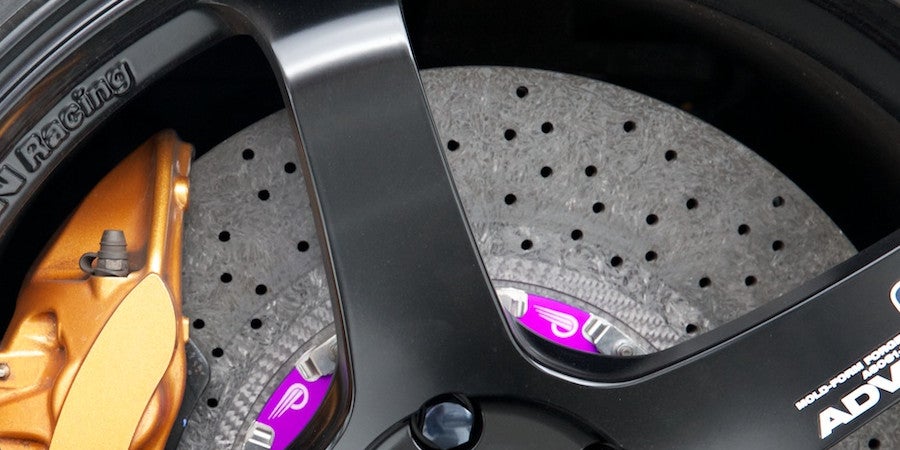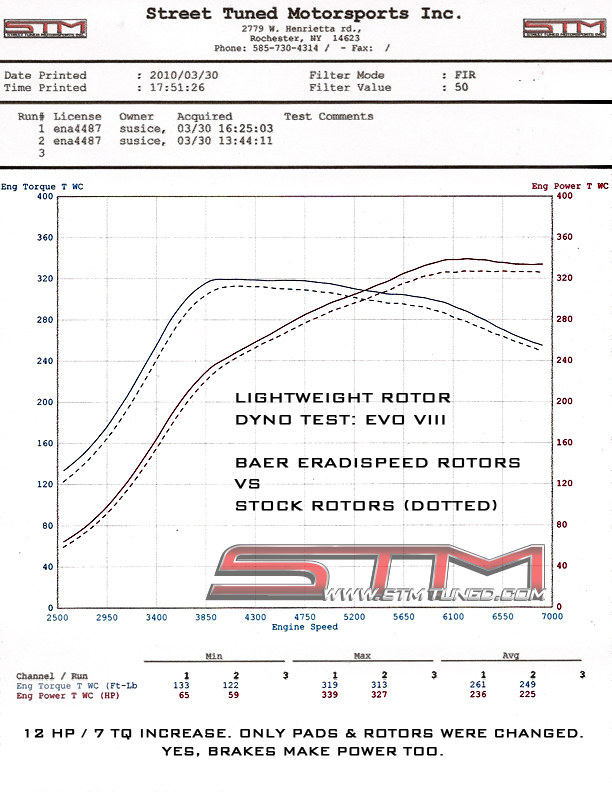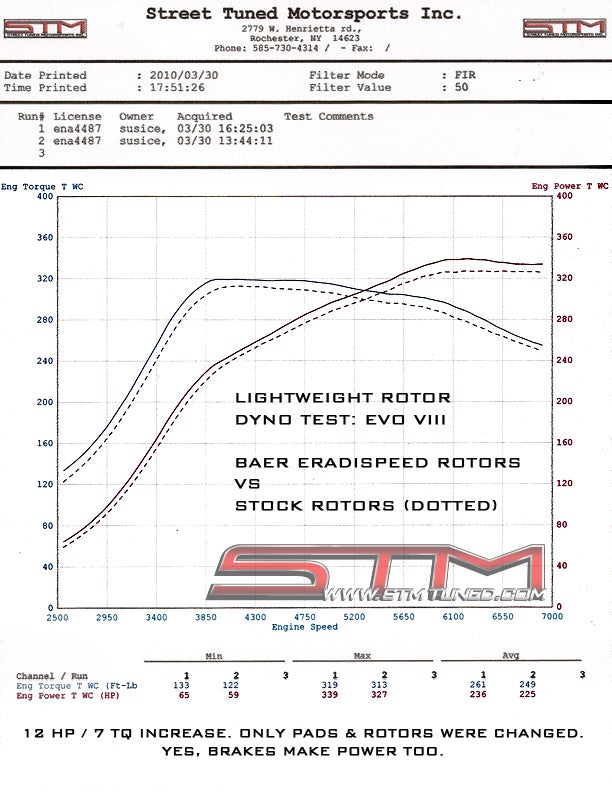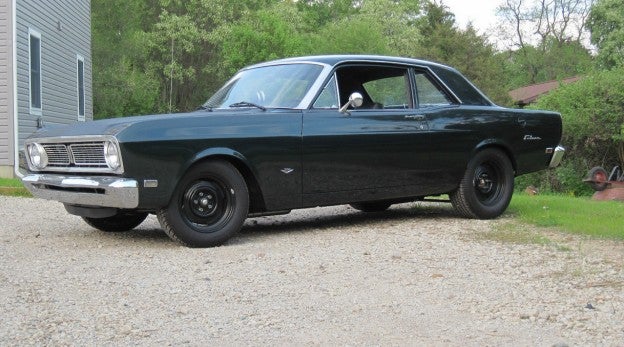 "RightFootDown" (rightfootdown)
"RightFootDown" (rightfootdown)
05/18/2015 at 13:53 ē Filed to: None
 4
4
 9
9
 "RightFootDown" (rightfootdown)
"RightFootDown" (rightfootdown)
05/18/2015 at 13:53 ē Filed to: None |  4 4
|  9 9 |

The most common car parts replaced in the name of performance are exhaust, suspension and wheels. All three of these parts can also make a car turn quicker, grip harder and accelerate faster. While each of the three components fulfills its own task, a common benefit shared between all three is generally reduced weight when compared to the factory counterpart. The lighter the vehicle, the less power it takes to accelerate, braking can be performed in less distance, and the car should pull more Gís through a corner.
!!!error: Indecipherable SUB-paragraph formatting!!!
BECAUSE RACECAR
Now what if I told you that replacing brake rotors could have a similar impact on performance?
Before we talk about lightweight brake rotors itís important to understand that replacing safety equipment all willy-nilly is not something to take lightly. In fact, I donít suggest it at all. Lightweight components may compromise integrity and may not be able to handle as much abuse as the factory parts. Weight reduction in any capacity generally means sacrificing something . In a street car that something is typically measurable by noise, vibration, or harshness. And if it doesnít affect those, it is probably very expensive.
!!! UNKNOWN HEADER TYPE (MULTI-LINE BREAK?) !!!
Enter lightweight brake rotors. Any company can manufacturer brake rotor that weighs less than stock. Itís rather simple. Non-performance brake rotors are usually cast in a single piece. Aftermarket manufacturers may choose to use metal alloys of less mass, save material by designing rotors to be thinner in critical areas, use different shaped cooling veins, or even add ďperformanceĒ features such as slots and cross drilled patterns.
But wait! Real race cars use slotted and cross drilled rotors! Yeah, sure some do, but those rotors you speak of are likely carbon ceramic and properly designed to take the abuse. Plus a pair of carbon ceramic for a street car will easily cost you five figures. Realistically, this isnít an option youíre going to pursue while at the local repair shop.
Lightweight Rotor Design
A more performance oriented method of reducing weight in brake applications is by utilizing a 2-piece design. In a 2-piece rotor, the center of the rotor, called the Ďhatí, is bolted to the Ďringí, the surface which contacts the brake pads. The sole job of the hat is simply to keep the ring in place, so this piece can be as light as possible so long as it keeps the hat aligned and in position. The hats in a 2-piece brake rotor are typically made of aluminum and that alone can save multiple pounds over a single piece cast brake rotor. Additionally, 2-piece rotors may be connected via pins that allows the ring to float freely and places less stress on the hat during heat expansion and contraction from cooling. This helps minimize the chances of warping rotors in off-road and race conditions. Another benefit in race applications is that the rings can be replaced instead of tossing away the entire rotor.
The largest percentage of weight in a traditional rotor comes from the ring itself. A manufacturer can find the right alloy, the perfect combination of slots or cross drilled sections and internal veining but thereís only so much weight that can realistically be shed. If you want to save the most weight in a the actual rotor, youíve got to look at carbon ceramic options. Carbon ceramic brake rotors weigh roughly half of a traditional rotor and more or less kick-ass when it comes to motorsport due to their heat resistance and better friction properties. Carbon ceramic rotors are also advertised to last four times longer than standard cast iron rotors. So why doesnít everyone run out to buy a set of carbon ceramic rotors? Currently, itís the price. A set of carbon ceramic rotors, if theyíre even available for your car, may run several thousand dollars for just a pair compared to a hundred dollars for a set of cast rotors.
Click Here For Original Article (Opens in New Window)
Real World Performance
Now letís talk horsepower. Simply changing your brake rotors will not magically increase your engineís power output. But it will free up power that was once lost in transfer to the ground. If youíve ever replaced a 25 lb cast wheel with a 18 lb forged wheel youíll know just how much of a difference unsprung weight can make. The same goes for brake rotors. Reducing rotational mass can yield great improvements in braking, turning and overall driving feel. How much horsepower? A small percentage likely comparable to under drive pulleys. Want hard numbers? Well, !!!error: Indecipherable SUB-paragraph formatting!!! dynoíd a Mitsubishi Evolution before and after installing a set of lightweight rotors. Emery at STM Tuned claimed the Evolution pulled 327 HP and 313 TQ and then jacked the car up while still on the dyno, replaced the rotors with Baer 2-piece rotors, and performed another dyno pull to the tune of 339 HP and 319 TQ. Thatís a gain of over 10 horsepower to the ground.


We were instantly curious to hear the weight difference between the two sets. We know you are too so here ya go:
!!! UNKNOWN CONTENT TYPE !!!
What we see is this particular 2-piece rotor saved roughly two pounds of rotational mass on each side up front and about three pounds per side on the rear for a total of ten pounds. Ten pounds doesnít sound like a good deal when factoring in the cost. Depending on the vehicle, a complete set of lightweight rotors may easily cost several thousand dollars. But consider the fact that a set of forged wheels could easily double that price and may just equal the weight savings.
For a weight-weeny, Iíd be all in for a set of lightweight rotors. Would love to see a back-to-back dyno comparison when swapping to carbon ceramic rotors.
Click Here For Original Article (Opens in New Window)
//Follow the author on Twitter !!!error: Indecipherable SUB-paragraph formatting!!!
Header Image:
!!!error: Indecipherable SUB-paragraph formatting!!!
Source:
!!!error: Indecipherable SUB-paragraph formatting!!!
 Party-vi
> RightFootDown
Party-vi
> RightFootDown
05/18/2015 at 14:09 |
|
Whatís that, $1,200 for 10hp? Thatís pretty expensive, but if it makes a difference at the track I guess nothing could be easier.
 Ash78, voting early and often
> RightFootDown
Ash78, voting early and often
> RightFootDown
05/18/2015 at 14:09 |
|
Hang on a sec. Iíve heard all the rotational/unsprung mass discussions for years, but always understood it to allow for quicker changes in speed. So acceleration would improve, ride and handling maybe a little, but youíre not actually going to get a different dyno result. How is this possible (in laymanís terms)?
 HiredDriver
> RightFootDown
HiredDriver
> RightFootDown
05/18/2015 at 14:28 |
|
This would imply that different wheel and tire combinations can also result in more power to the ground. Iíd also venture to guess that an AWD vehicle would yield larger gains on the dyno than front or rear driven.
 crowmolly
> Ash78, voting early and often
crowmolly
> Ash78, voting early and often
05/18/2015 at 14:56 |
|
Less mass to turn, so less horsepower loss.
This is why a have to shake my head at the ZOMGZ STEELIES posts.
 bryan40oop
> RightFootDown
bryan40oop
> RightFootDown
05/18/2015 at 15:14 |
|
Much more weight loss, not that much of a difference. Me thinks this article is full of shit.
 Party-vi
> crowmolly
Party-vi
> crowmolly
05/18/2015 at 15:32 |
|

but steelies look amazing.
 RightFootDown
> bryan40oop
RightFootDown
> bryan40oop
05/18/2015 at 15:44 |
|
Are you saying that a small reduction of rotational mass canít possibly result in a faster lap time?
 bryan40oop
> RightFootDown
bryan40oop
> RightFootDown
05/18/2015 at 16:34 |
|
No, not at all. But youíre not gaining that much HP/TQ
 FastIndy
> Ash78, voting early and often
FastIndy
> Ash78, voting early and often
05/19/2015 at 09:58 |
|
It depends on what kind of dyno you use. An inertial dynamometer measures how quickly an engine can accelerate a large rotating mass. The vehicleís own wheels, tires, geartrain, and engine also contribute to that mass, becoming a small part of that system. You can think of that power as being invested into rotational energy in those parts instead of applied to the dyno mass.
When you have something like a brake dyno, where the engine speed is held constant and varying loads are applied, then inertial effects are not included. This is arguably a better way to determine an engineís exact steady state output.
The real world effect is basically equivalent to the inertial dyno, however. Decrease the moment of inertia your flywheel, rotors, gears, wheels, etc either by making them lighter or reducing their diameter, and a greater proportion of the engineís torque will be applied where the rubber meets the road, quite literally.
Note that this power isnít being lost, just stored in the form of rotational kinetic energy.